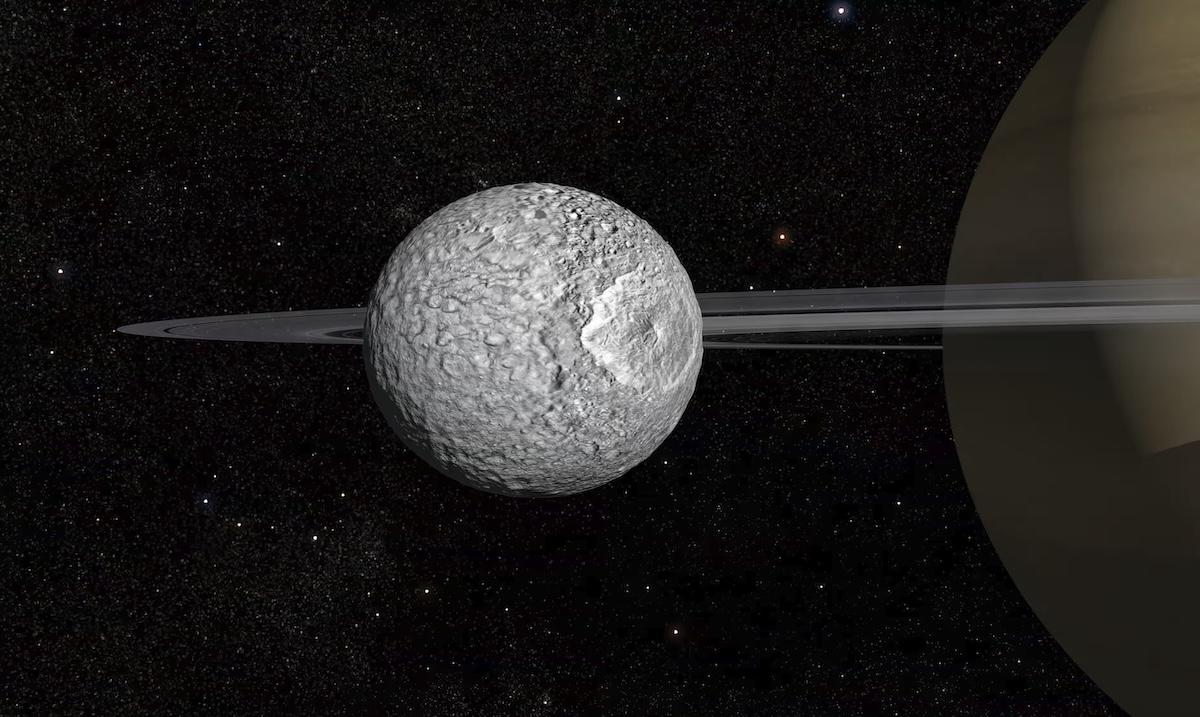
Moon of Saturn Nicknamed "Death Star" Said to Have Hidden Ocean Under Crust
Researchers have uncovered a concealed ocean beneath the surface of Saturn's Mimas, a moon noted for its resemblance to the Star Wars Death Star due to a large impact crater. This discovery places Mimas, a 250-mile-wide icy sphere, in a distinguished group alongside Saturn's Titan and Enceladus and Jupiter's Europa and Ganymede, all of which are known to contain hidden oceans.
Valéry Lainey, an astronomer at the Observatoire de Paris, highlighted the unexpected nature of this finding, pointing out the absence of visible signs on Mimas's surface that would indicate an underwater ocean, making it an improbable candidate for such a feature.
The investigation into Mimas's unique orbit, propelled by data from NASA’s Cassini mission, led to the revelation. The team, through detailed analysis of the moon's spin and orbit, determined that Mimas must have a subsurface ocean to account for its observed movements. Lainey emphasized that the only plausible explanation for Mimas's behavior is a global ocean beneath its icy exterior, enabling the moon's shell to move independently from its core.
This subterranean ocean, estimated to be 45 miles deep and situated beneath a 15-mile-thick layer of ice, is thought to comprise over half of Mimas's volume, with sea floor temperatures reaching into the tens of degrees Celsius. These findings, published in the journal Nature, suggest a complex internal structure within Mimas that was previously unanticipated.
Mimas's ocean, by astronomical measures, is considered relatively nascent, believed to have formed within the last 25 million years. This development was driven by Saturn's strong tidal forces, which reshaped and heated Mimas's core, akin to the warming effect on a squash ball when massaged. This process led to the melting of the ice above the core, culminating in the formation of an ocean within the moon. Despite the harsh surface conditions marked by numerous impacts, including the significant Herschel crater named after William Herschel, the discoverer of Mimas in 1789, the ocean beneath remains a point of intrigue.
The existence of global oceans under the surfaces of moons in the Saturnian and Jovian systems has sparked significant interest among space agencies, motivated by the potential for these oceans to support life. Enceladus, for example, has demonstrated this potential vividly with over 100 geysers ejecting water vapor through its surface cracks, suggesting that if microbial life exists, it could be disseminated into space, making detection by missions possible.
Given Mimas's scenario of having water in proximity to warm rock, Valéry Lainey does not dismiss the possibility of life. However, he cautions that the ocean's relatively recent formation might not have allowed sufficient time for life to develop. The question of whether its youthful ocean could sustain life remains open, with Lainey adopting an optimistic "why not?" stance.
Contrastingly, David Rothery, a planetary geosciences professor, points out that while Mimas's subsurface ocean adds it to the list of celestial bodies of interest, there are more accessible targets in the search for extraterrestrial life. He highlights the lack of evidence for a connection between Mimas's internal ocean and its surface or space, which would facilitate the detection and sampling of life signs, unlike the plumes of Enceladus or potential studies on Europa. Rothery notes that the thick ice covering Mimas's ocean would pose a significant barrier to detecting life, suggesting that moons like Europa and Enceladus, with more direct indications of habitability, are likelier candidates for hosting life.









